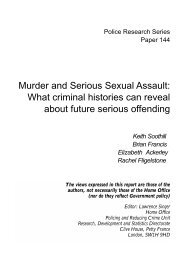Policing Large Scale Disorder: Lessons from the disturbances of ...
Policing Large Scale Disorder: Lessons from the disturbances of ...
Policing Large Scale Disorder: Lessons from the disturbances of ...
Create successful ePaper yourself
Turn your PDF publications into a flip-book with our unique Google optimized e-Paper software.
Home Affairs Committee: Evidence Ev w21<br />
— In his evidence to this Committee in December 2010 Simon Chesterton, ACPO lead, noted that <strong>the</strong><br />
“national guidance is that Taser should not be used in relation to public demonstrations”, and<br />
Amnesty International UK and Omega recommend that this be made more explicit in ACPO<br />
guidance relating to crowd control and <strong>the</strong> use <strong>of</strong> Taser.<br />
12. Moreover o<strong>the</strong>r “distance weapons”, although currently not used in UK policing, are being reviewed by<br />
<strong>the</strong> Centre for Applied Science and Technology (CAST). A report by CAST’s predecessor, <strong>the</strong> Home Office<br />
Scientific Development Branch, states that directed energy weapons—including ocular weapons and millimetre<br />
waves—”could in <strong>the</strong> future provide a capability for <strong>the</strong> UK Police to engage individuals at a greater range<br />
and with more precision than is currently achievable”. 11 Acoustic weapons such as <strong>the</strong> Long Range Acoustic<br />
Device (LRAD) have been used for crowd control in Canada and <strong>the</strong> USA, although not without controversy.<br />
Such weapons have serious medical and human rights implications. Their introduction would also represent a<br />
significant deviation <strong>from</strong> <strong>the</strong> British model <strong>of</strong> policing.<br />
13. Acoustic weapons are relatively indiscriminate, targeting sections <strong>of</strong> <strong>the</strong> crowd instead <strong>of</strong> targeting<br />
specific individuals within it, and <strong>the</strong> same level <strong>of</strong> exposure has been reported to affect individuals differently.<br />
Studies have noted “very high variable individual sensitivity” 12 to acoustic weapons, with noise induced<br />
hearing loss seeming to occur randomly. 13 There are also a number <strong>of</strong> health risks associated with <strong>the</strong> use <strong>of</strong><br />
such weapons, particularly at close range, loud volume and/or excessive lengths <strong>of</strong> time. Such risks range <strong>from</strong><br />
temporary pain 14 to permanent hearing damage. 15<br />
14. Whilst millimetre wave systems are designed to produce nothing more than pain, or possibly short term<br />
redness or blistering, 16 longer exposure, especially one at higher power, could lead to second or third degree<br />
burns. If such burns occur over 20% or more <strong>of</strong> <strong>the</strong> body <strong>the</strong>y become life threatening and require specialist<br />
burns treatment. At least one such exposure was reported during <strong>of</strong>ficial testing 17 and <strong>the</strong> risk <strong>of</strong> such<br />
consequences may be exacerbated in crowd situations where individuals may be unable to move out <strong>of</strong> <strong>the</strong><br />
way <strong>of</strong> <strong>the</strong> beam.<br />
— We recommend that ACPO guidance states more explicitly that electro-shock devices are<br />
inappropriate for crowd control.<br />
— We agree with <strong>the</strong> Committee’s earlier recommendation on <strong>the</strong> use <strong>of</strong> “distance weapons” for crowd<br />
control and recommend fur<strong>the</strong>r that <strong>the</strong>re is specific reference to emerging technologies such as<br />
acoustic and millimetre wave weapons.<br />
Guidance on Attenuating Energy Projectiles (AEPs) and Watercanon<br />
15. Amnesty International UK and Omega note that <strong>the</strong> police decision to refrain <strong>from</strong> using water cannon<br />
was appropriate under <strong>the</strong> circumstances; indeed, as Sir Hugh Orde noted, it was not suitable for this type <strong>of</strong><br />
disturbance. 18 Fur<strong>the</strong>r, <strong>the</strong> ACPO/APCOS/NPIA Manual <strong>of</strong> Guidance on Keeping <strong>the</strong> Peace (hi<strong>the</strong>rto referred<br />
to as Keeping <strong>the</strong> Peace) states that a possible criteria for use <strong>of</strong> Attenuating Energy Projectiles (AEP) include<br />
“situations <strong>of</strong> serious public disorder where <strong>the</strong>re is <strong>the</strong> potential for loss <strong>of</strong> life, serious injury or widespread<br />
destruction”. Whilst <strong>the</strong> police were thus enabled to use AEPs, <strong>the</strong>ir decision to refrain <strong>from</strong> doing so was<br />
appropriate under <strong>the</strong> circumstances. Indeed, as <strong>the</strong> ACPO Attenuating Energy Projectile (AEP) Guidance<br />
(amended 16 May 2005) notes, “<strong>the</strong> AEP has not been designed for use as a crowd control technology but has<br />
been designed for use as a less lethal option in situations where <strong>of</strong>ficers are faced with individual aggressors<br />
whe<strong>the</strong>r such aggressors are acting on <strong>the</strong>ir own or as part <strong>of</strong> a group”.<br />
16. AEPs were introduced as a safer alternative to <strong>the</strong>ir predecessor, <strong>the</strong> L21A1 plastic baton round.<br />
However, an analysis <strong>of</strong> <strong>the</strong> injury patterns caused by <strong>the</strong> AEP highlighted an unexpectedly high rate <strong>of</strong> serious<br />
injuries to <strong>the</strong> head and upper body which contradicted previous research. 19 The study found that “<strong>the</strong> AEP<br />
requires ongoing evaluation, and it is too early to conclude that it provides a safer alternative to <strong>the</strong> L21A1.”<br />
— We recommend that fur<strong>the</strong>r research and evaluation is undertaken into <strong>the</strong> AEP in order to better<br />
understand <strong>the</strong> associated injury pattern and risks.<br />
11 HOSDB (2008). Less Lethal Technologies Review <strong>of</strong> Commercially Available and Near-Market Products for <strong>the</strong> Association <strong>of</strong><br />
Chief Police Officers Publication No. 49/08<br />
12 NATO (2004). RTO Technical Report: Non-Lethal Weapons and Future Peace Enforcement Operations TR-SAS-040<br />
13 The Canadian Centre for Occupational Health and Safety quoted in Bradford Non-lethal Weapons Research Project (2005) Nonlethal<br />
weapons: saving lives but still serious areas <strong>of</strong> concern presented at Jane’s 8th Annual Less Lethal Weapons Conference,<br />
<strong>the</strong> Royal Armouries, Leeds.<br />
14 Bradford Non-lethal Weapons Research Project (2005) Non-lethal weapons: saving lives but still serious areas <strong>of</strong> concern<br />
presented at Jane’s eighth Annual Less Lethal Weapons Conference, <strong>the</strong> Royal Armouries, Leeds.<br />
15 NATO (2004). op cite<br />
16 JNLWP (Joint Non-Lethal Weapons Program), Frequently Asked Questions Regarding <strong>the</strong> Active<br />
Denial System, 31 Oct. 2006, www.jnlwp.com/Resources/Misc/FAQ%20FINAL%2031%20OCT%2006.pdf<br />
17 K.Osborn, Airman injured in heat bean test, Army Times, 7 April 2007. www.armytimes.com/news/2007/04/defense_<br />
burnedairman_070405/ accessed 27 June 2011<br />
18 Orde, H (2011). Now is not <strong>the</strong> time for <strong>the</strong> police to use water cannon and baton rounds. Available online at<br />
www.guardian.co.uk/commentisfree/2011/aug/10/water-cannons-baton-rounds-hugh-orde<br />
19 Maguire, K et al (2005). “Injuries caused by <strong>the</strong> attenuated energy projectile: <strong>the</strong> latest less lethal option” in Emergency Medical<br />
Journal 2007; 24:103–105
















